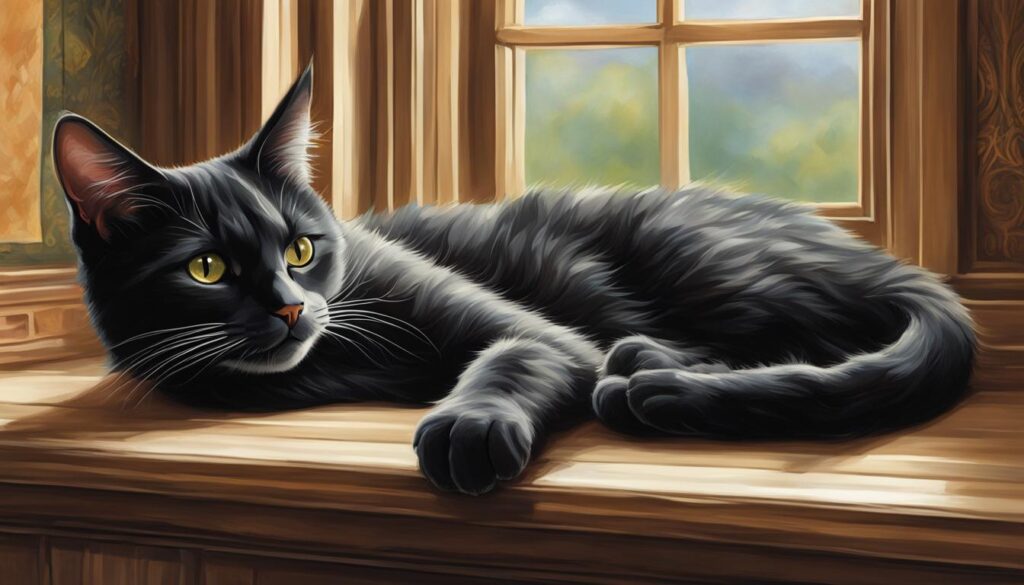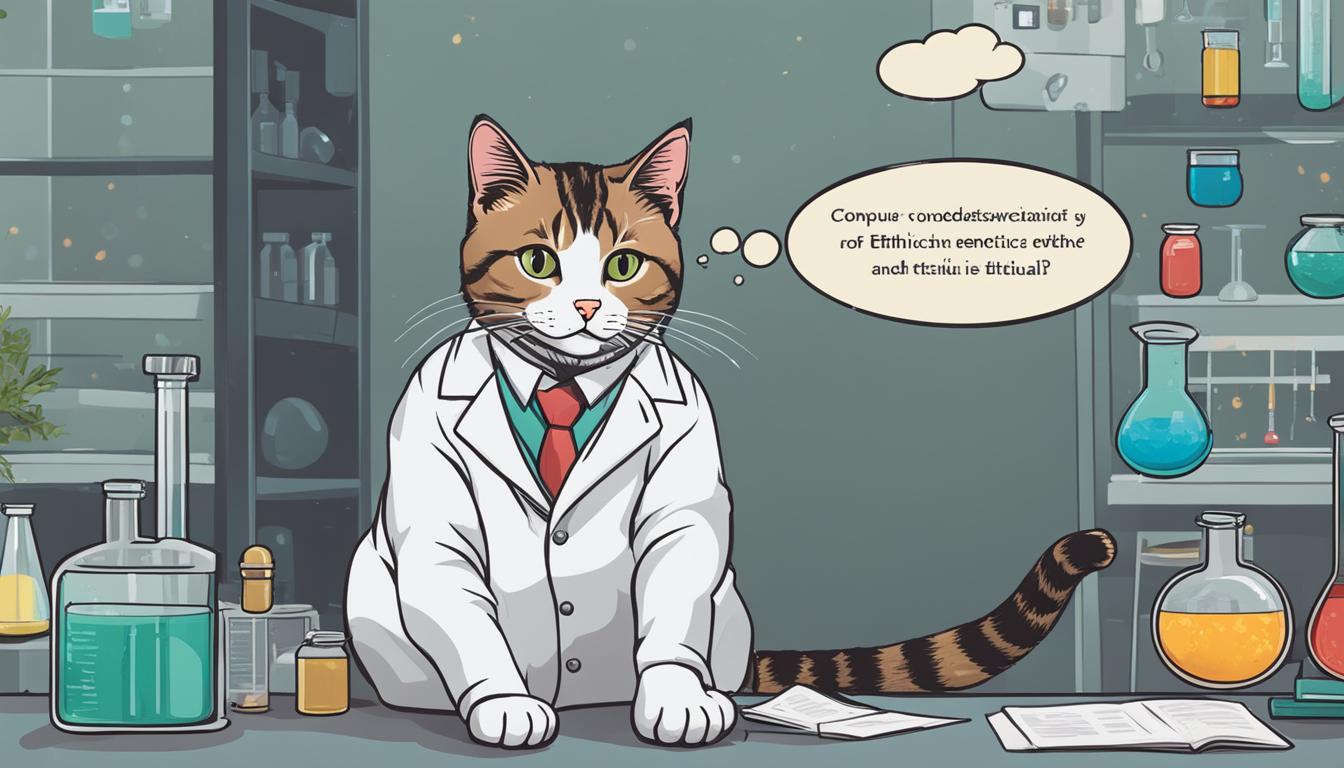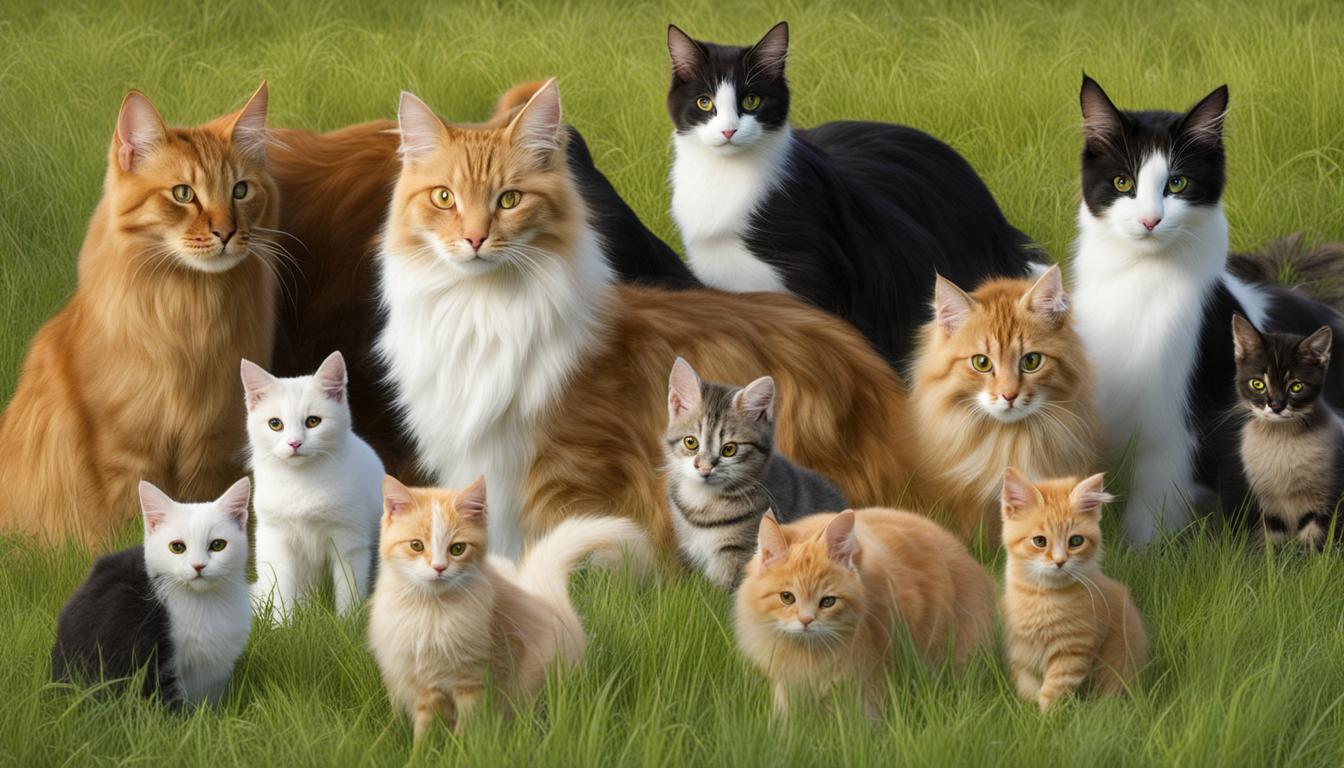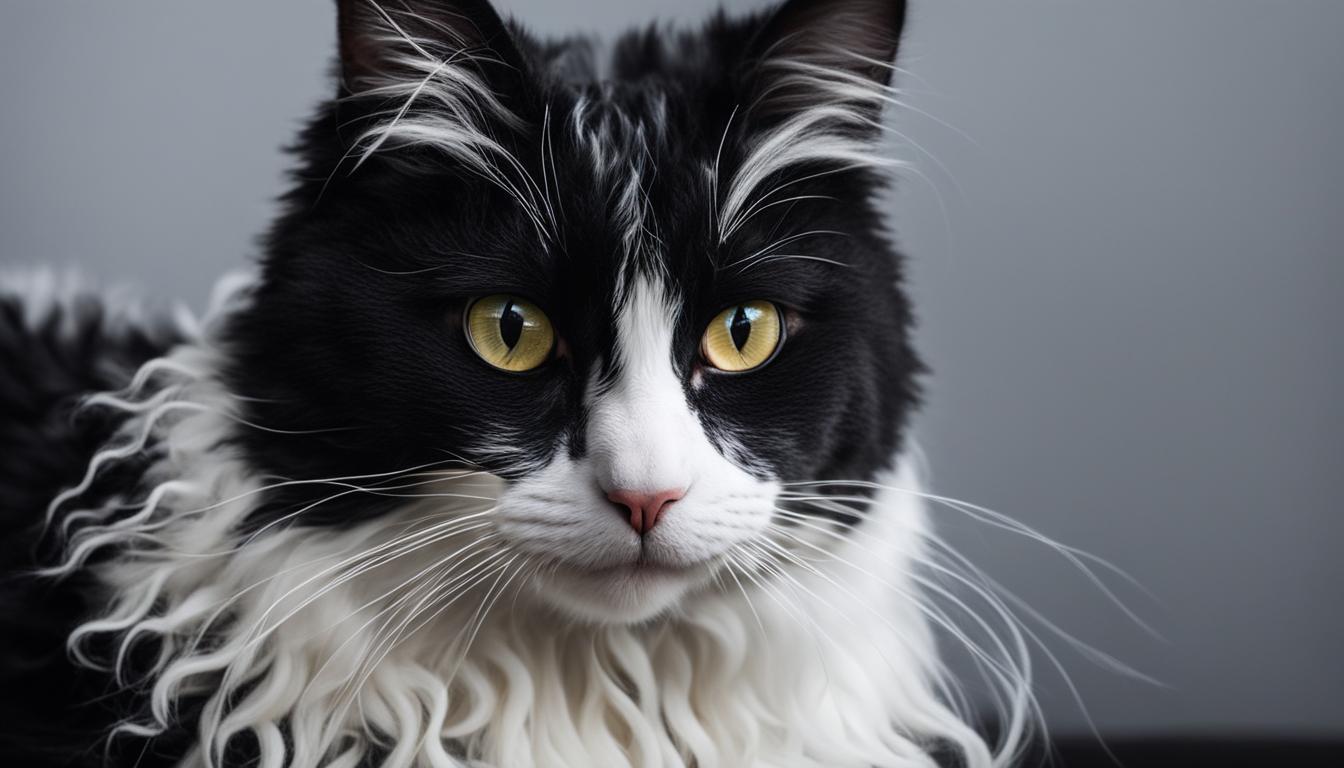Have you ever come across a cat with extra toes? If so, you’ve encountered a polydactyl cat! These unique felines possess a genetic anomaly called polydactyly, which results in the presence of more than the usual number of toes on one or more of their paws. It’s a fascinating genetic trait that has captured the curiosity of many, including me.
Polydactyly is not exclusive to cats; it can be found in various species, from humans and dogs to horses and birds. However, it is most commonly associated with the Maine Coon breed of cats. Polydactyl cats can have two forms of polydactyly: post-axial and pre-axial. Post-axial polydactyly refers to the appearance of extra digits on the outer side of the paw, while pre-axial polydactyly involves extra digits on the inside of the paw.
The genetic basis of polydactyly in cats is linked to a mutation in the ZRS cis element of the Pd gene, which targets the Shh gene, leading to the formation of additional digits. While polydactyl cats may experience symptoms such as lameness, infections, and irregular nail growth, most of them do not require treatment and have a good prognosis.
Key Takeaways:
- Polydactyl cats have a genetic anomaly called polydactyly, resulting in extra toes on one or more paws.
- Polydactyly can be found in various species, but it is commonly associated with the Maine Coon breed of cats.
- There are two forms of polydactyly in cats: post-axial and pre-axial.
- The genetic mutation causing polydactyly in cats is associated with the ZRS cis element of the Pd gene, which targets the Shh gene.
- Polydactyl cats may experience symptoms such as lameness, infections, and irregular nail growth, but in most cases, they do not require treatment.
The History and Popularity of Polydactyl Cats
Polydactyl cats, also known as Hemingway cats, have a fascinating history that dates back several centuries. It is believed that these cats were brought on ships by English Puritans in the 1600s, making their way to Boston and eventually Halifax. Sailors considered polydactyl cats to be lucky companions during stormy weather, as their extra toes provided them with improved balance. Additionally, these cats were highly valued for their exceptional hunting skills, particularly in controlling shipboard rodent populations.
Over time, polydactylism became more prevalent in certain regions, such as New England and the Maritime provinces of Canada. The association with the famous author, Ernest Hemingway, contributed to the popularity of these cats. Hemingway was gifted a six-toed polydactyl cat by a ship captain, and the descendants of this cat still roam the grounds of his former home in Key West, Florida. These cats became known as Hemingway cats, further cementing their place in history.
Today, polydactyl cats continue to capture the imagination of cat enthusiasts and genetic researchers alike. The study of polydactylism in cats has shed light on the intricate workings of feline genetics, particularly the inheritance patterns of this unique trait. Genetic research on polydactyl cats has provided valuable insights into the underlying mechanisms that cause the development of extra toes, contributing to our understanding of genetic variations in animals.
I find it fascinating how polydactyl cats have such a rich history and hold a special place in popular culture. Their unique genetic trait has captivated people for centuries, and it’s incredible to see how these cats have been celebrated and cherished throughout time. From serving as lucky ship companions to becoming beloved members of Ernest Hemingway’s household, polydactyl cats truly have a remarkable story to tell.

The Popularity of Polydactyl Cats
The allure of polydactyl cats goes beyond their unique genetics. Their distinct appearance, with their extra toes, often gives them a charming and whimsical appeal. Their popularity has led to the establishment of the Maine Coon Polydactyl as a recognized breed, distinct from the regular Maine Coon. Breeders who appreciate this genetic quirk have even created breeding programs specifically to maintain and promote polydactylism in certain cat breeds, such as the Pixie-bob.
While polydactyl cats may have an interesting history and increased popularity, it’s important to remember that they are still just like any other feline companion. Their genetics may set them apart, but they require the same love, care, and attention as any other cat. By embracing their unique traits and providing them with a safe and nurturing environment, we can continue to enjoy the presence of these charming Hemingway cats in our lives.
| Breed | Common Name | Polydactyl Prevalence |
|---|---|---|
| Maine Coon | Maine Coon Polydactyl | Common |
| Pixie-bob | Pixie-bob Polydactyl | Accepted |
| Domestic Shorthair | Hemingway Cat | Varies |
The Genetics of Polydactyl Cats
Polydactyly in cats is an intriguing genetic phenomenon that results in the presence of more toes than usual on one or more of their paws. This unique trait is inherited through a simple autosomal dominant pattern, meaning that cats with extra toes have the dominant gene PD. Cats with only one copy of the gene from either parent have a 50% chance of expressing the polydactyl trait in their offspring. However, the exact reasons for the higher frequency of polydactyly in cats compared to other species are still unknown.
The genetic mutation causing polydactyly in cats is associated with a specific region known as the ZRS cis element in the Pd gene. This mutation targets the Sonic hedgehog (Shh) gene and causes the expression of the Shh gene in a different organizer region on the posterior side of the limb. As a result, additional digits are formed during development. This genetic anomaly is fascinating as it provides insights into the intricate mechanisms of digit formation and patterning.
To summarize, polydactyl cats have a dominant gene for extra toes, which can be passed on to their offspring. The ZRS cis element mutation in the Pd gene targets the Shh gene, leading to the formation of additional digits during development. While the exact reasons for the higher prevalence of polydactyly in cats remain unknown, the study of polydactyl cats provides valuable insights into the genetics of limb development and patterning.
| Genetic Characteristics of Polydactyl Cats | Details |
|---|---|
| Inheritance Pattern | Autosomal Dominant |
| Gene Associated with Polydactyly | Pd gene |
| Specific Mutation | ZRS cis element mutation |
| Target Gene | Sonic hedgehog (Shh) gene |
| Location of Extra Digit Formation | Posterior side of the limb |
Health Concerns and Treatment for Polydactyl Cats
Polydactyl cats, with their extra toes, may experience certain health concerns related to their unique genetic trait. One of the primary symptoms of polydactyly is the presence of extra phalangeal growth on one or more paws. The size and structure of these additional digits can vary among cats. While not all polydactyl cats face health issues, there are specific concerns that owners should be aware of.
Some polydactyl cats may experience lameness, which can occur when the extra digits interfere with normal movement. These abnormal toes may become fused at birth, leading to painful irregularities and making the cat prone to infections. Nail bed infections and irregular nail growth are common in polydactyl cats, requiring regular nail care and monitoring to prevent complications.
In most cases, polydactyl cats do not require treatment as the prognosis is generally good. However, if complications arise, such as recurring infections or severely affected limbs, surgical removal of the extra digits may be considered. This procedure aims to alleviate pain and prevent further complications. It is important to consult with a veterinarian to determine the best course of action for each individual cat.
Although there are potential health concerns associated with polydactyly, it is essential to note that not all polydactyl cats will experience these issues. With proper care and monitoring, most polydactyl cats can lead happy, healthy lives. Regular veterinary check-ups and maintaining good hygiene practices, such as trimming nails, can help prevent and address any health concerns that may arise.

Table: Common Health Concerns in Polydactyl Cats
| Health Concerns | Description |
|---|---|
| Lameness | Difficulty in movement due to interference from extra digits. |
| Infections | Nail bed infections or other complications related to abnormal toes. |
| Irregular Nail Growth | Abnormal nail growth patterns requiring regular care. |
| Fusion of Extra Digits | Painful abnormalities resulting from fused extra digits at birth. |
It is important to note that the information provided in this table is for informational purposes only and should not replace veterinary advice. If you have any concerns about your polydactyl cat’s health, please consult a veterinarian for personalized guidance.
Fascinating Facts about Polydactyl Cats
Polydactyl cats, with their unique genetic anomaly of extra toes, have captured the attention of researchers and cat lovers alike. Here are some interesting facts about these fascinating felines:
1. Popularity and Famous Associations
Polydactyl cats gained popularity due to their association with the famous American writer, Ernest Hemingway. Hemingway was fond of these cats and had a colony of them at his home in Key West, Florida. Today, many of the descendants of Hemingway’s polydactyl cats still reside at the Hemingway House, which is now a museum.
2. Wide Range of Extra Toe Configurations
Polydactyl cats can have varying numbers and arrangements of extra toes. While most polydactyl cats have extra toes on their front paws, some may also have them on their back paws. The number of extra toes can range from one to several, and their size and structure can differ as well.
3. Nicknames and Regional Associations
Polydactyl cats have acquired various nicknames based on their unique traits. In addition to being called “Hemingway cats,” they are also known as “mitten cats” or “thumb cats” due to the appearance of their enlarged paw pads. These cats are especially prevalent in certain regions, such as New England and Nova Scotia, where their presence is often linked to their historical arrival on ships.
| Region | Nickname |
|---|---|
| New England | Boston Thumb Cats |
| Nova Scotia | Nova Scotia’s Six-Toed Cats |
| Florida | Hemingway’s Cats |
Polydactyl cats continue to fascinate us with their unique genetic trait. Their popularity, famous associations, and range of extra toe configurations make them truly captivating feline companions.
Conclusion
Genetics can be absolutely fascinating, especially when it comes to the world of polydactyl cats. These curious felines have captured our attention with their extra toes and unique genetic anomaly known as polydactyly. Through genetic research, scientists have discovered that a mutation in the ZRS cis element of the Pd gene is responsible for this intriguing trait.
While polydactyly is more commonly seen in cats compared to other species, the exact reasons for this higher frequency remain a mystery. However, what we do know is that polydactyl cats have become quite popular and are often referred to as Hemingway cats, thanks to their association with the famous American writer.
Despite the potential for health concerns, such as lameness or infections, polydactyl cats generally have a good prognosis and typically do not require treatment. They continue to captivate us with their unique genetic feature, reminding us of the wonders of nature and the intriguing world of genetics.
FAQ
What is polydactyly in cats?
Polydactyly in cats is a genetic anomaly characterized by the presence of more than the usual number of toes on one or more of their paws.
What causes polydactyly in cats?
Polydactyly in cats is associated with a mutation in the ZRS cis element of the Pd gene, which targets the Shh gene and causes additional digit formation.
Are polydactyl cats common?
Polydactyl cats are more commonly seen in cats compared to any other mammalian species.
Do polydactyl cats require treatment?
In most cases, polydactyl cats do not require treatment and have a good prognosis. However, if complications arise, surgical removal of the extra digits may be performed.
Are polydactyl cats associated with any specific breed?
Polydactyl cats are often associated with the Maine Coon breed and have two forms of polydactyly: post-axial and pre-axial.
Why are they called Hemingway cats?
Polydactyl cats are often referred to as “Hemingway cats” due to their association with the famous American writer, Ernest Hemingway, who had a fondness for them.
Can polydactyl cats pass on the polydactyly trait to their offspring?
Yes, polydactyl cats can pass on the polydactyly trait to their offspring. It is a simple autosomal dominant trait, meaning that cats with extra toes have the dominant gene PD.
Source Links
- https://basepaws.com/blog/genetics-of-polydactyly-celebrating-the-hemingway-cats
- https://www.halifaxvethospital.com/does-your-feline-have-extra-toes-the-history-behind-polydactyl-cats/
- https://d43fweuh3sg51.cloudfront.net/media/media_files/098464fd-5a17-4d9d-a277-cdafe2dc8253/182f0aca-0d98-47eb-a25b-7e9a7ed29c60.pdf





